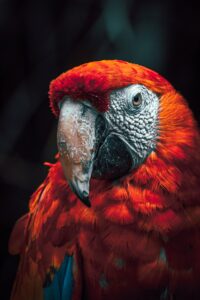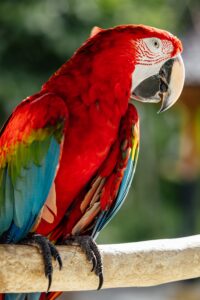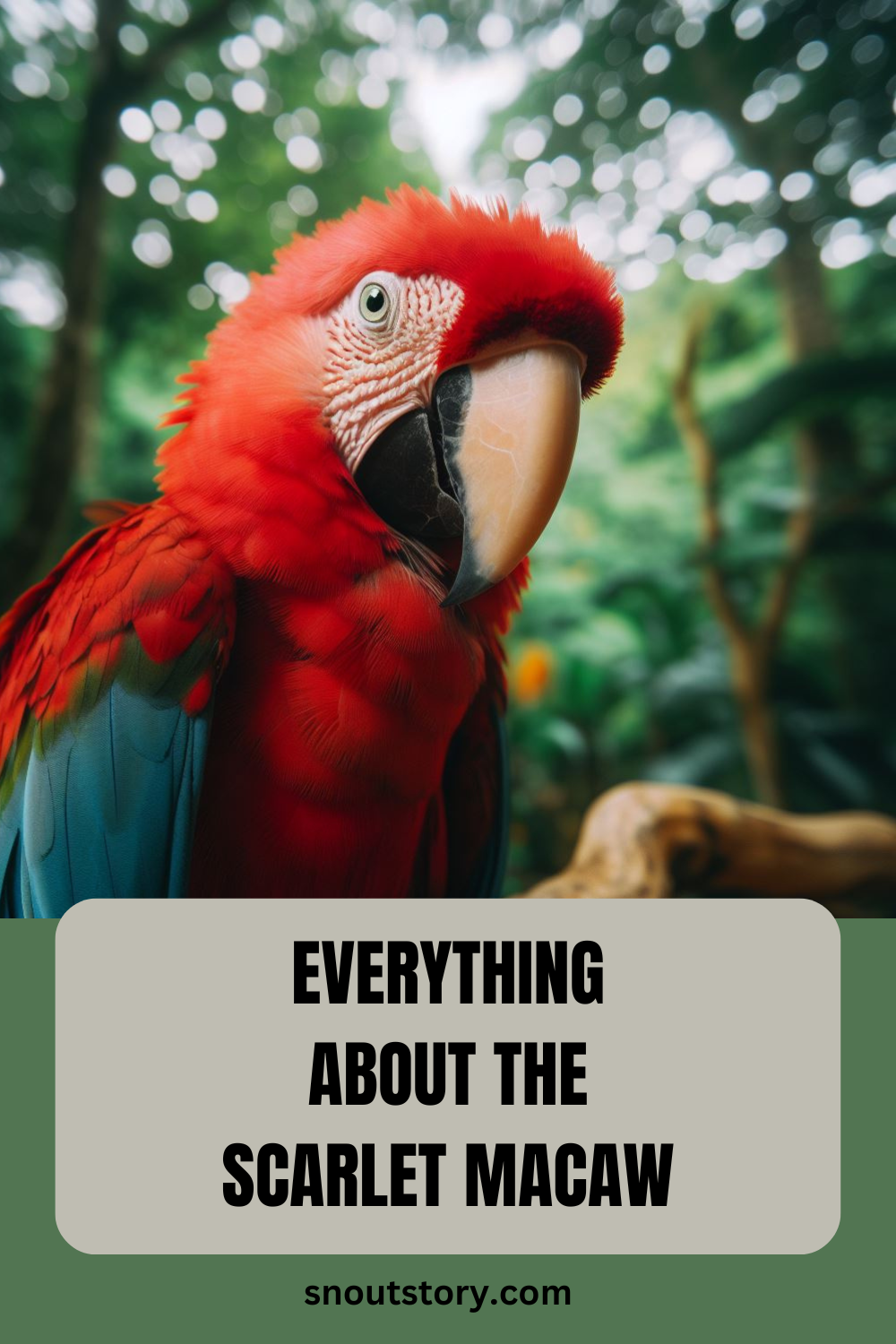The origins and habitat of the Scarlet Macaw provide a fascinating glimpse into the natural world of these magnificent birds. Indigenous to the tropical rainforests of Central and South America, Scarlet Macaws are known for their vibrant plumage and lively personalities. These stunning creatures thrive in lush, humid environments, where they can find ample food sources and suitable nesting sites.
Their habitat ranges from lowland forests to mountainous regions, where they roost in tall trees and forage for fruits, nuts, seeds, and insects. Scarlet Macaws play a vital role in the ecosystem as seed dispersers, helping to maintain the biodiversity of their native habitats. Unfortunately, deforestation and habitat loss pose significant threats to their survival, highlighting the importance of conservation efforts to protect these iconic birds and their natural habitat for future generations.
Physical Characteristics of the Scarlet Macaw
The physical characteristics of the Scarlet Macaw showcase the awe-inspiring beauty and unique features of these remarkable birds. With their vibrant plumage dominated by shades of red, blue, and yellow, Scarlet Macaws are instantly recognizable and admired for their striking appearance.
Their large size, reaching up to 33 inches in length, and impressive wingspan of over 3 feet make them an imposing sight in their natural habitat. Not only are their feathers visually stunning, but they also serve practical purposes, aiding in communication, camouflage, and thermoregulation.
The powerful beak of the Scarlet Macaw is adapted for cracking nuts and seeds, while their strong legs and feet enable them to navigate and perch among the treetops with ease. Beyond their physical attributes, Scarlet Macaws possess intelligence, curiosity, and a playful nature that endears them to bird enthusiasts around the world.
Diet and Feeding Habits of Scarlet Macaws
The diet and feeding habits of Scarlet Macaws reflect their natural behavior and dietary preferences in the wild. These majestic birds are primarily herbivores, with a diet consisting mainly of fruits, nuts, seeds, and berries found in their native rainforest habitat. In addition to foraging for food in trees, Scarlet Macaws are also known to visit clay licks, where they consume mineral-rich clay to supplement their diet and aid in digestion.
Providing a varied and balanced diet is essential for their health and well-being in captivity, with commercial pelleted diets specifically formulated for large parrots serving as a nutritious base. Supplementing their diet with fresh fruits, vegetables, and occasional treats helps mimic their natural feeding habits and provides enrichment. Offering opportunities for foraging and food puzzles further stimulates their natural instincts and encourages mental and physical activity. By understanding and accommodating the dietary needs of Scarlet Macaws, owners can ensure they thrive in captivity and lead fulfilling lives.
Behavior and Social Structure of Scarlet Macaws

The behavior and social structure of Scarlet Macaws offer a fascinating glimpse into the complex dynamics of these highly intelligent and social birds. In their natural habitat, Scarlet Macaws are often observed living in pairs or small family groups, forming strong bonds with their mates and offspring. They communicate with each other through a variety of vocalizations, including squawks, screams, and raucous calls, which serve to establish territory, attract mates, and coordinate activities within the group. These vocalizations are also a means of expressing emotions and maintaining social cohesion.
Additionally, Scarlet Macaws engage in elaborate courtship rituals, such as mutual preening and vocal duets, to strengthen pair bonds and ensure reproductive success. Their social interactions are not only essential for breeding but also for mutual protection, foraging, and sharing of resources within the group. By understanding the behavior and social structure of Scarlet Macaws, we gain insight into their intricate social lives and the importance of companionship in their well-being.
Breeding and Reproduction of Scarlet Macaws
Breeding and reproduction in Scarlet Macaws are fascinating processes that showcase the natural instincts and behaviors of these iconic birds. Typically, Scarlet Macaws reach sexual maturity around 3 to 4 years of age, at which point they begin forming pair bonds with a mate. During the breeding season, which varies depending on geographical location, pairs engage in elaborate courtship displays, including mutual preening, vocalizations, and aerial acrobatics, to strengthen their bond and synchronize their reproductive efforts.
Once a pair has bonded, they work together to select a suitable nesting site, typically a hollow tree or cliffside crevice. The female then lays a clutch of 2 to 4 eggs, which both parents take turns incubating for about 24 to 28 days. After hatching, the parents diligently care for and feed their chicks until they fledge and become independent, usually around 3 to 4 months of age. The breeding and reproductive behaviors of Scarlet Macaws exemplify the intricate dynamics of pair bonding, parental care, and ensuring the survival of their offspring in their natural habitat.
Interaction With Humans: Keeping Scarlet Macaws as Pets

The interaction between Scarlet Macaws and humans when kept as pets is a topic that requires careful consideration and responsible ownership. While these magnificent birds can form strong bonds with their human companions and provide enriching experiences, it’s essential to understand the unique needs and challenges of keeping them in captivity. Scarlet Macaws thrive on social interaction, mental stimulation, and physical activity, requiring plenty of time and attention from their owners to remain happy and healthy.
Providing a spacious and stimulating environment, including ample opportunities for flight, play, and exploration, is crucial for their well-being. Additionally, positive reinforcement training methods can help foster trust and cooperation, allowing for enjoyable interactions and minimizing potential behavioral issues. It’s important to remember that Scarlet Macaws are long-lived birds with complex needs, and their ownership should be approached with careful consideration, commitment, and respect for their natural instincts and behaviors.
Training and Enrichment for Scarlet Macaws as Pets
Training and enrichment play vital roles in the well-being of Scarlet Macaws kept as pets, fostering mental stimulation, physical activity, and a strong bond between bird and owner. Positive reinforcement training techniques, such as clicker training and target training, can be used to teach basic commands, encourage desirable behaviors, and provide mental challenges for the bird.
Enrichment activities, such as puzzle toys, foraging opportunities, and interactive games, help satisfy their natural curiosity and intelligence while preventing boredom and behavioral issues. Additionally, incorporating regular flight exercises and outdoor time in a safe and supervised environment allows Scarlet Macaws to engage in natural behaviors and maintain physical health. By implementing effective training and enrichment strategies, owners can ensure their Scarlet Macaws lead fulfilling and enriching lives in captivity.
Health Considerations for Scarlet Macaws
Maintaining the health of Scarlet Macaws involves proactive care and attention to their unique needs as captive birds. Regular veterinary check-ups are essential for monitoring their overall health and detecting any potential issues early on. Scarlet Macaws are susceptible to common avian health problems such as respiratory infections, feather picking, and nutritional deficiencies, so it’s crucial to provide a balanced diet, proper hygiene, and a stress-free environment to minimize these risks.
Additionally, ensuring ample opportunities for exercise, mental stimulation, and social interaction contributes to their overall well-being. By prioritizing preventive care and addressing any health concerns promptly, owners can help their Scarlet Macaws live long, healthy, and vibrant lives as cherished companions.
Fun Facts and Trivia about Scarlet Macaws
- Scarlet Macaws are highly intelligent birds capable of learning to mimic human speech and solve simple puzzles.
- Their vibrant plumage serves both an aesthetic purpose and aids in communication and camouflage in their natural habitat.
- Despite their majestic appearance, Scarlet Macaws are affectionate and social creatures, forming strong bonds with their human companions.
- They have been revered by indigenous cultures for centuries, often depicted in ancient artwork and mythology as symbols of power, beauty, and spiritual connection to nature.
Recommended
Scarlet Macaw : Health, Lifespan and Care (Everything New Owner Must Know)
8 Easy Training Techniques for Your Scarlet Macaw (Build An Unbreakable Bond)
Scarlet Macaw : Creating An Ideal Cage Setup (Everything A New Owner Should Know)
Scarlet Macaw : Food and Diet (Everything New Owners Should Know)

Vedant Narvekar is an experienced digital marketing expert with a profound love for nature and animals. With a career rooted in leveraging online platforms to drive engagement and promote meaningful causes, Vedant’s passion for animals inspired him to start Snout Story—a blog dedicated to educating people about pet keeping and sharing proper knowledge about caring for animals. Drawing on his expertise in digital marketing, Vedant utilizes his platform to advocate for responsible pet ownership, providing valuable insights on pet care, training, nutrition, and more. Through Snout Story, Vedant aims to empower pet lovers with the information they need to provide the best possible care for their furry companions, while also fostering a deeper appreciation for the natural world and the creatures that inhabit it.





